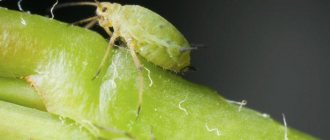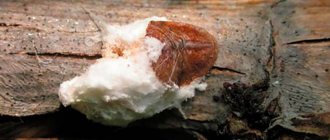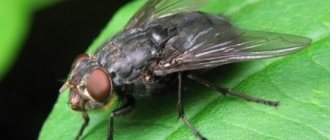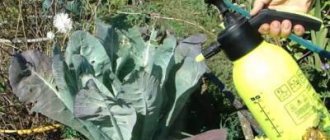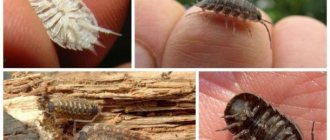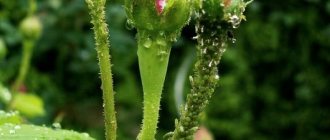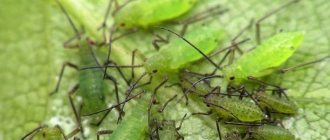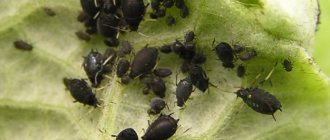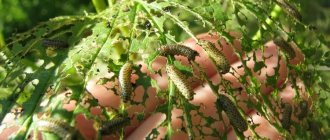Aphids are considered one of the main enemies of cabbage. Small insects literally attack vegetables and spoil them, interfering with the normal development of the crop. As a result, the crop may be damaged or even destroyed beyond repair.
You can get rid of aphids on cabbage using folk remedies; they act quickly and are completely harmless to the vegetable itself.
- What harm can aphids cause to cabbage?
- The best folk remedies for aphids Vinegar
- Tobacco
- Ammonia
- Ash
- Tar soap
- Potato and tomato tops
- Sagebrush
- Garlic and onion
- Chamomile
- Bay leaf
- Fitoverm
- Aggressor
Varieties of aphids that parasitize cabbage
Aphids are the most common type of parasite that attacks all garden plants. Insects belong to the order Homoptera, and there are about 4 thousand subspecies, ¼ of which live on the European continent. Aphids are voracious and ready to feed on any plant. However, there are also individuals that prefer only a certain type of greenery.
Subspecies of insects found in cabbage beds and living in Russia:
- large potato aphid. 4 mm individuals, both wingless (red or green with antennae) and winged (greenish, with brown antennae). In addition to cabbage, it causes harm to potatoes (the most favorite delicacy), tomatoes and beets;
- cabbage aphid. Dimensions do not exceed 4 millimeters. Color – light green, with a grayish tint and brown antennae. The pest prefers cruciferous plantings and, in addition to cabbage, is found on radishes and radishes. This subspecies most often worries gardeners with attacks on cabbage crops.
Preventive measures
Preventive methods include interspersing cabbage bushes with garden crops that repel aphids. These include: fennel, carrots, lettuce, onions, chamomile. By planting cabbage between rows, you can protect the plant from pests. You also need to observe crop rotation. Having planted cruciferous crops twice on one plot, you can expect an aphid attack next year.
The best predecessors: garlic, legumes, carrots. After harvesting the cabbage, you need to dig up and get rid of the above-ground parts where insects lay “overwintering” larvae. The soil needs to be dug up and fertilizing added.
Rules of care and timely processing
There is no need to wait until aphids attack cabbage; you can protect the future harvest by preventative spraying of the garden before planting. Special agents are used that act on insects through the soil or directly on them. Before transplanting, young seedlings are also processed.
Once the plant has taken root, it can be sprayed with a mild insecticide. Treatment can be carried out when the first ovaries appear. It is not recommended to poison cabbage with chemicals after flowering; this may negatively affect the harvest in the future.
Attention: It is prohibited to use insecticides near water bodies, since many products have a negative effect on fish. They should not be used near apiaries: bees may die during active use.
Causes of insects
Aphids reproduce at an incredible rate, so one female that flies into the garden is usually enough to seriously infect cabbage. Females breed throughout the season, and most often lay eggs on last year's plant remains, and the hatched larvae quickly attack cabbage beds. Eggs laid on greenery in the fall survive the winter without any problems.
Another method of infection is ants. Feeding on the juice that aphids secrete, ants often take eggs into anthills, keeping them warm, and in the spring they responsibly distribute the eggs throughout the garden.
Prevention
There are a number of preventive measures that will help protect your garden from aphids:
- in late autumn, completely clear the area from the remains of vegetable crops, dry them and burn them, and do not keep them in the garden;
- in the fall, carefully dig up the soil to a depth of at least 25 cm;
- fight weeds in a timely manner, removing them from all paths;
- use mixed planting technology, planting herbs and tobacco near the cabbage bed;
- follow the rules of crop rotation, planting cabbage after carrots, onions and legumes;
- pay special attention to fertilizing cabbage, since aphids appear on weak young plants that are not fertilized enough.
Advantages and disadvantages of using folk remedies
The war against aphids using traditional methods undoubtedly has advantages:
- safety. Perhaps this is the most important point, especially for those gardeners who have animals or small children. Folk control measures are not toxic and do not harm beneficial insects, soil or the plant itself;
- simplicity. It is more than simple to prepare a mixture to combat aphids yourself; you just need to follow the instructions and advice;
- cheapness. Traditional therapy products do not require special expenses and are sold in any store.
See also
Is it possible to spray cabbage with valerian against pests and processing rules?
Read
Despite the positive aspects, traditional methods of killing parasites still have several disadvantages:
- duration of treatment. Compared to chemicals, safe products take longer to kill the parasite;
- not resistant to moisture. Mixtures and infusions are easily washed off by rain or dew, but this can be corrected by adding soap.
Folk methods of fighting aphids, proven by many generations
These small pests are most often located on the lower part of cabbage leaves. Therefore, in order to recognize their presence, it is necessary to carefully examine the seedling. In addition, after vegetables are damaged by aphids, the leaves become pale and curl into tubes, their growth slows down and dark spots that are sticky to the touch can be seen with the naked eye. To prevent crop loss, you need to start fighting aphids immediately after you notice them in your garden.
Before using any of the methods, it is necessary to remember that spraying seedlings against pests should be done in the evening in calm and dry weather.
Advantageous neighborhood
Most often, aphids are not the only insect living in your garden during the summer season, so this method will be effective not only against aphids, but also other parasites. It involves planting tobacco between the rows of cabbage. This plant will help get rid of not only aphids, but also caterpillars and some species of beetles.
Also, for preventive purposes, cabbage is planted next to tomatoes, which repel pests with their smell. For the same purpose, marigolds, lavender or calendula are sown along the edges of the bed.
Sagebrush
You can repel pests from vegetables by planting wormwood around the perimeter of the garden or directly next to the seedlings. Its smell will completely repel pests.
For the same purpose, you can scatter fresh wormwood branches between the rows or treat the cabbage with a decoction. To prepare the solution, take 1 kg of grass, add a small amount of water, bring to a boil and cook for 15 minutes. After the broth has cooled, it must be strained and diluted in 10 liters of water. For greater effectiveness in the fight against aphids, you can add 50 grams of any soap base (powder, dishwashing liquid, hand soap, etc.) to the resulting composition.
Ash and tobacco
A popular way to combat aphids is a solution of ash and tobacco. To prepare the product, take 200 grams of each ingredient, which are diluted in 10 liters of water. All components are mixed and adjusted throughout the day, after which the resulting mixture is filtered and sprayed onto the cabbage.
Ash, tobacco and pepper
A mixture of ash and spices has repellent properties. To do this, you need to take 100 grams of wood ash, 1 teaspoon of ground red pepper and 100 grams of tobacco dust. All ingredients must be mixed and the resulting mixture sprinkled on the ground around the plant. After which the soil is loosened to a depth of 2 cm. This procedure must be repeated every five days until the parasites completely disappear.
Spraying tobacco
Since these insects cannot tolerate the pungent smell of tobacco, you can prepare a decoction by taking 200 grams of fresh tobacco leaves and pouring 5 liters of water over them. Bring to a boil and cook for about 2 hours. After which the broth is allowed to cool completely, then it is filtered, liquid soap is added and the resulting composition is sprayed directly onto the seedlings.
An equally interesting article: How to use baking soda in the garden and what are the benefits of this substance
Powered by Inline
Pest-resistant cabbage varieties
If the crop is often attacked by pests, then gardeners should pay attention to specially bred varieties that are not inferior in taste, but are resistant to aphids:
- Aggressor F1. Frost-resistant, late-ripening, white cabbage comes from Holland. Incredibly resistant to pests and extremely unpretentious.
- Amager 611. Late-ripening hybrid. It is characterized by high productivity and strong immunity to pests and diseases.
- Bartolo F1. Another late-ripening hybrid of Dutch origin. It is resistant to diseases and pests and produces high yields.
Why is it dangerous?
Harmful insects feed on cabbage juice, which leads to weakening of the plant. As a result, vital processes are disrupted, the development of the plant is suspended, and it dies.
As aphids reproduce, they form entire colonies. As a result, not only the cabbage suffers, but also the plants growing nearby.
If you do not start fighting aphids in time, there is a risk of death of many plantings. In addition to harming the plant, insects carry viruses and bacteria. Since aphids are omnivorous, they easily attack a wide variety of plants. In addition, it is capable of transferring diseases from diseased bushes to healthy ones.
Description of cabbage aphids and harm from them
Aphids are insects belonging to the order Homoptera. There are many types of pests. Cruciferous crops are affected by the green cabbage aphid. The size of its oval body does not exceed 4 mm in length. There are brown antennae on the head.
The mouthparts of pests are of the piercing-sucking type. With its help, insects damage the surface of cabbage leaves and feed on the juice. Aphids reproduce very quickly - in one season they produce offspring up to 15 times.
In spring and the first half of summer, wingless aphids inhabit vegetable gardens; in July–August, winged pests hatch from eggs. They easily move long distances, attacking untouched cabbage plantings.
Why is the pest dangerous?
- Huge hordes of insects deprive the plant of nutrients and vitality. As a result, the cabbage leaves curl and dry out. The gardener risks losing his harvest.
- Insects are carriers of diseases of vegetable crops. Moving from one plant to another, pests contribute to the spread of viruses, bacteria and fungi, which causes diseases: black leg, gray rot, mucous bacteriosis.
Aphids secrete a sweet-tasting liquid that ants like. The latter are interested in the well-being of pests and protect their breadwinners in every possible way. Ants guard aphid eggs, and in the spring they transfer them to different plants, thereby facilitating the spread of insects.
Attention! The fight against aphids on cabbage is carried out comprehensively. To get rid of pests, you will have to eliminate the accomplices of winged insects - ants.
Professional preparations
You can save cabbage from pest invasion with the help of biologically active preparations and chemical insecticides. Popular ones are:
- Fitoverm;
- Spark;
- Tanrek;
- Aktara.
Deltamethrin
Broad-spectrum insecticide. Blocks the transmission of nerve impulses, causing paralysis and death. A minimal amount of poison is enough to cause death. It begins to act during processing and retains its properties for about 20 days.
On a note!
The drugs Decis pro, Fas, and Atom are produced based on deltamethrin. Before use, prepare the solution according to the instructions, diluting the concentrate in cool water. Treat the plant with a spray bottle.
Spark
You can poison aphids with the insecticide Iskra. Available in several variations, the names include the prefix - Gold, Bio, Double Effect. It is produced in the form of concentrated liquid, powder, pressed tablets.
Pesticides for insect pests
Before spraying, prepare a solution. The cabbage protection after treatment lasts 20 days. During this time, adults and larvae of all ages die. Females do not lay new eggs.
Important!
To consolidate the effect, re-treatment is carried out after 15 days, then for prevention once a month throughout the growing season. The break between the last spraying and harvest should be at least 20 days.
Pyrethrum
The biological preparation is based on the action of a substance obtained from a special type of chamomile. The drug is safe for humans, does not affect the development of cabbage, but is fatal to aphids. Pyrethrum is diluted in water and sprayed once every 2 weeks throughout the vegetable growing season.
